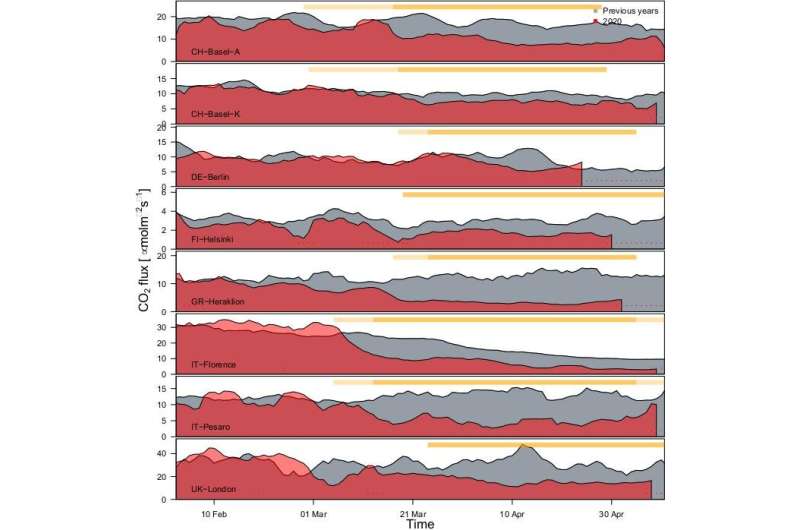Average daily emissions from February 5th to May 6th, 2020 (red area) and average of the previous years during the same period (grey area). The dark-orange horizontal bars cover the periods of official lockdowns while the light-orange bars indicate periods of partial lockdown or general restrictions (e.g. schools closed, personal contact reductions, mobility constraints). Credit: ICOS Ecosystem Thematic Centre (ETC)
COVID-19-related restrictions have forced many people to stay at home. This has strongly reduced road traffic and economic activities, particularly in cities and urban areas where the majority of the population lived. Consequently, this has also cut down human-induced carbon dioxide (CO2) emissions to the atmosphere.
Although this reduction is not strong enough to be globally visible in the atmosphere, at local scale the changes in emissions can be observed.
Carbon dioxide emissions reduced even by 75 percent
The study, which is currently being prepared for peer review, shows that lockdown has so far reduced carbon dioxide emissions in all participating cities. "The reductions range from 8% in a highly vegetated urban area of Berlin, Germany, to 75% in the city center of Heraklion in Greece," says Professor Dario Papale, director of the ICOS Ecosystem Thematic center, where he is involved with research activities dedicated to the study of climate change impacts on agriculture, forests and ecosystem services.
The European cities included in the study are Basel in Switzerland, Berlin in Germany, Florence and Pesaro in Italy, Helsinki in Finland, Heraklion in Greece and London in the UK. The size of reduction varied due to the characteristics of the sampled areas and the stringency of the lockdown restrictions in place. In all cities, there was a clear temporal connection with the restrictions and the emission reduction.
For the local observations, the scientists globally use a technique called eddy covariance, in which the exchange of carbon dioxide between the atmosphere and a particular ecosystem is measured by equipment installed in towers topping over the area and its vegetation. This allows the researchers to see the changes in nearly real-time.
Traffic, vegetation, economic and domestic activities affect reduction
The tower in Heraklion observed the largest reduction. The area is characterized by dense commercial activities and intense road traffic, both of which completely stopped during the lockdown. In Pesaro, the almost full stop of all traffic reduced CO2 emissions up to one-third of the normal amount. In other cities, such as Florence and Helsinki, the emissions reductions result from a combination of reduced traffic and economic activities, while increased domestic heating and human metabolism partly counterbalance the reduction. In the Basel-B location, however, normal traffic is twofold higher than Basel-K, and for this reason, the reduction is larger.
Traffic and the commercial sector cause a large part of London's emissions, but London differs from Helsinki and Florence due to is residential contribution: Normally, the weekday population in daytime central London increases 10-fold due to the influx of commuters. This decreased strongly with lockdown.
In Berlin, the moderate reduction in traffic has been counterbalanced by domestic emissions and the presence of vegetation, leading to relatively small fluxes.
Clear connection to restriction orders visible
The connection of lockdown measures to emissions and the connected timing can be clearly seen from the figure. "In some cases (Florence, London and Heraklion), emissions began decreasing even some time before the official lockdown was implemented, when people responded to recommendations to reduce travel and work from home as much as possible," Dario Papale says. "This is a great example of collaboration among scientists in different countries, which is supported by local authorities who allow us to collect these important measurements. Flux measurements will be very important for monitoring the emission patterns in the coming weeks and months, when private cars will possibly be preferred to public transport to avoid crowds. This might cause a fast growth of emissions that may even exceed those of the pre-lockdown period."
The scientists aim to make further studies based on the data generated from these city towers. While this early analysis paves the way for more in-depth studies, it already shows the importance of observation towers in urban areas. This significance of cities will also grow in the future: Some 55% of the world's population lives in cities, and according to United Nations, that percentage will grow considerably over the coming decades.
More information: Dario Papale, et al. Clear evidence of reduction in urban CO2 emissions as a result of COVID-19 lockdown across Europe. (PDF) data.icos-cp.eu/objects/w6pTmRGYKqAm3c-siQrg5kgd
Provided by CMCC Foundation - Euro-Mediterranean Center on Climate Change
























